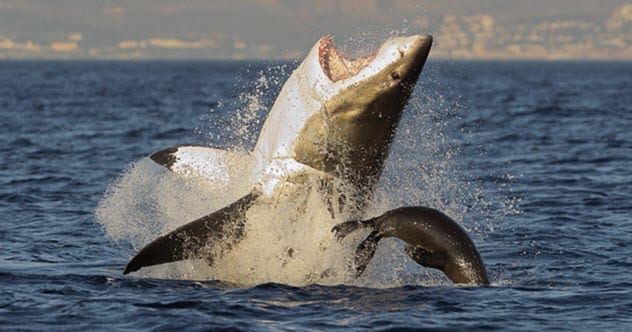Ever since Jaws made its debut, sharks have been portrayed as relentless killing machines. But how much of what we think we know about sharks is actually true? Let’s dive in and debunk ten of the most widespread misconceptions about these misunderstood creatures.
1. Sharks Are Nature’s Most Efficient Killing Machines
While sharks are predators, they aren’t necessarily nature’s most efficient killers. Many shark species are intelligent and calculating hunters. They patiently stalk their prey, waiting for the opportune moment to strike. But, plenty of other organisms are far more efficient at causing fatalities, including viruses. There are over 500 identified species of sharks, each with varying hunting techniques and diets.
2. Sharks Are Maneaters
The “maneater” label is a scary one, fueled by movies and popular culture. However, most sharks live their entire lives without ever encountering a human. Earth’s oceans are vast. Most people only enter waters along coastlines, leaving a significant portion of the ocean untouched by humans. The majority of shark species are opportunistic feeders that prefer small fish and invertebrates. Only about a dozen species have been involved in attacks on humans, usually mistaking a person for their natural prey.
3. Sharks Are At The Top Of The Food Chain
While it’s true that sharks are formidable predators, they aren’t always at the very top of the food chain. Humans kill more sharks than any other creature, though we aren’t part of their natural food chain. Killer Whales, or Orcas, are known to prey on even the largest Great White sharks. These whales have been observed attacking Great Whites to consume their livers, showcasing that even the apex predators can become prey.
4. Sharks Can’t Get Cancer
The myth that sharks can’t get cancer has been around for a while, even leading to the misguided belief that consuming shark cartilage can prevent the disease. Malignant tumors have been found in sharks since the late 19th century. The misconception may stem from the fact that cancer is relatively rare in sharks compared to other animals. A 1992 book titled Sharks Don’t Get Cancer: How Shark Cartilage Could Save Your Life promoted the idea, despite a lack of scientific evidence.
5. Sharks Will Die If They Stop Swimming
The idea that sharks must constantly swim to survive is linked to how they breathe. Sharks extract oxygen from the water using their gills. Some species, like Great Whites and Mako Sharks, rely on “ram ventilation.” This is when they swim with their mouths open, forcing water through their gills. However, other species like Bullhead and Nurse Sharks use “buccal pumping.” This involves drawing water into the mouth and over the gills while remaining still. Only the obligate ram ventilators will suffocate if they stop swimming.
6. Sharks Can Detect A Single Drop Of Blood From Miles Away
Sharks do have an acute sense of smell, crucial for hunting. But, their olfactory capabilities aren’t quite as supernatural as often portrayed. Sharks use their nostrils exclusively for smelling, lined with cells that can detect chemicals interpreted as smells. Some sharks can detect low concentrations of substances at a few hundred meters. Certain species can detect compounds at 1 part per billion, equivalent to a single drop in a swimming pool. While their sense of smell is impressive, it’s far more limited than the myth suggests.
7. Sharks Can Swim Backward
Unlike most fish species, sharks cannot swim backward. Most fish can flick their pectoral fins to move in reverse, but sharks have anatomical limitations. Sharks swim forward by using their tails to push water around their fins, which they use to stabilize and steer. Because the pectoral fins don’t curve upwards, sharks are limited to forward movement. If a shark moves backward, it’s usually due to gravity. Backward movement can also be harmful, potentially leading to suffocation in some species due to the need to move water over their gills.
8. Sharks Are Only Found In Saltwater
While most sharks inhabit the world’s oceans, there are notable exceptions. Six species of River Sharks, belonging to the genus Glyphis, live exclusively in freshwater environments in Southeast Asia, South Asia, New Guinea, and Australia. Unfortunately, these species are rare due to habitat degradation. Bull Sharks also spend significant time in freshwater, traveling up rivers like the Mississippi and Amazon. One Bull Shark was found 2,500 miles up the Amazon River, demonstrating their adaptability to freshwater.
9. All Sharks Are Deadly To Humans
The assumption that all sharks are deadly to humans is far from accurate. Out of around 500 known shark species, only about a dozen have been known to bite humans, accounting for just 2.4% of all sharks. Numerous species pose no threat to people. The Whale Shark, the largest fish in the world, is a filter feeder with no interest in humans. Though a shark bite can cause serious injury, the vast majority of sharks are harmless to humans.
10. Sharks Can “Go Rogue” And Hunt Only Humans
The concept of “rogue sharks” that specifically target humans is unfounded. Sharks do not suddenly develop a taste for humans and actively seek them out as prey. When a shark bites a human, it typically realizes it isn’t their usual food and moves on. Second bites are rare. In 2020, there were only 57 unprovoked shark attacks globally, with a small percentage resulting in fatalities. The odds of being attacked by a shark are extremely low, around 1 in 3,748,067.
By understanding the reality behind these myths, we can appreciate sharks for what they really are: complex and fascinating creatures. They play a vital role in marine ecosystems, and dispelling these misconceptions is key to fostering respect and conservation efforts.
What surprised you most about these shark myths? Leave your comment below and let’s discuss!










